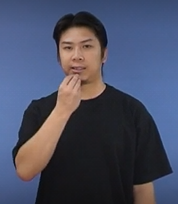Central to Stokoe’s simultaneous model of sign language phonology (1960/2005) is his suggestion that American Sign Language exhibits ‘duality of patterning’ (Sandler, 2012). ‘Duality of patterning’ is one of the design features of human languages according to Hockett (1960). To illustrate what duality of patterning is in spoken languages, let’s take a look at some English examples first. In English, there are individual consonants (e.g., d, f, p, t, k, m, n, l) and vowels (e.g, æ, u, ə, a, ɒ, i). These consonants and vowels do not bear their own meanings. However, these meaningless sounds can be combined to form meaningful words.
For example:
| /k/ + /æ/ + /t/ | > | [kæt] ‘cat’ |
| /d/ + /ɒ/ + /g/ | > | [dɒg] ‘dog’ |
| (meaningless individual sounds) | (meaningful words) |
Hockett named this two-level combinatorial structure for word formation ‘duality of patterning’. According to Hockett, duality of patterning allows human languages to create meaningful units (i.e., morphological level) by combining a limited number of meaningless units (i.e., phonological level). These meaningful units can be further combined to form other larger words. Duality of pattern is observed in all spoken languages.
Stokoe (1960/2005) demonstrated that ASL signs could be created from a limited set of meaningless elements. Hence, similar to spoken words, signs can also show ‘duality of patterning’. For example, in ASL, the sign APPLE consists of the following phonological elements:
APPLE – ASL
| Handshape | Hook hand | |
| Location | Cheek | |
| Movement | Twisting movement |
These elements, namely, hook hand, cheek and twisting movement, do not carry their own meanings. When they are combined together, they form the sign APPLE. The sign NEED in Hong Kong Sign Language is another example that illustrates how meaningless elements can be combined to form a meaningful sign. NEED consists of the following phonological elements. In this sign, none of the four formational units carries its own meaning. When combined together, however, they mean NEED in HKSL.
HKSL: NEED

| Handshape | An extended index finger | |
| Location | Neck | |
| Movement | Contactual action | |
| Non-manuals | Lip-rounding |
With duality of patterning, speakers/signers can make use of a finite number of small, meaningless units to create an unlimited number of words and expressions. This is an important feature of natural languages. As time progresses and our society advances, there are novel concepts and things that require new linguistic labels. Duality of patterning allows human languages to remain productive enough to meet this ever-growing communication need. In fact, Hockett argued that duality of patterning is one of the linguistic features that distinguish human languages from animal communication systems.
Stokoe (1960/2005) and Hockett (1960) were published in the 1960s. Over the past six decades, there have been plenty of discussions concerning the universality of duality of patterning, and why human languages are structured in this way (e.g., de Boer et al., 2012). Although duality of patterning is observed in sign languages as well, not all signs are made up of just meaningless units. Unlike spoken languages, sign languages are visual languages, which can accommodate more visually iconic elements at the level of sign formation (Sandler et al., 2011). Hence, a sign may consist of sub-lexical units that are visually iconic, i.e., not entirely meaningless. Take the sign EAT in Hong Kong Sign Language as an example The sign mimics a human hand putting food into one’s mouth. Hence, the handshape, location and movements are meaning-bearing rather than meaningless. However, it is still possible for us to break down a lexical sign into several sub-lexical units. Hence, sign languages still exhibit two distinct combinatorial levels.
HKSL: EAT

References
- de Boer, B., Sandler, W., & Kirby, S. (2012). New perspectives on duality of patterning: Introduction to the special issue. Language and cognition, 4(4), 251-259.
- Hockett, C. (1960). The origin of speech. Scientific American, 203, 89-96.
- Sandler, W., Aronoff, M., Meir, I., & Padden, C. (2011). The gradual emergence of phonological form in a new language. Natural language and linguistic theory, 29, 502-543.
- Sandler, W. (2012). The phonological organization of sign languages. Language and linguistic compass, 6(3), 162-182.
![]()
